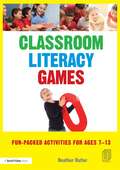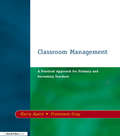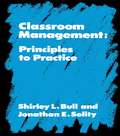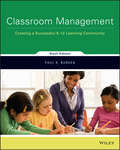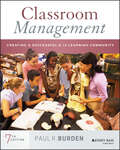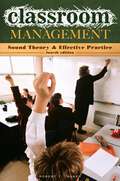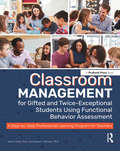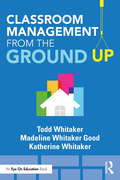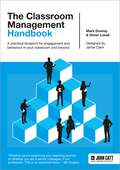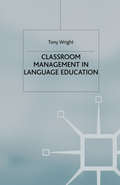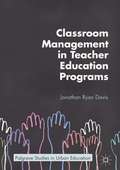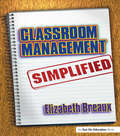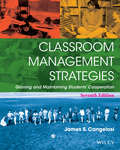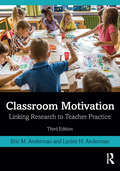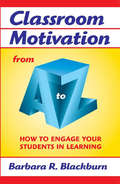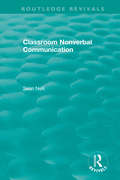- Table View
- List View
Classroom Literacy Games: Fun-packed activities for ages 7-13
by Heather ButlerChildren enjoyed it so much they didn’t realise they were being worked so hard.Jo Miles, Learning Support Assistant at Manor Farm Community Junior School, Hazlemere, Buckinghamshire Great speaking and listening activity-setting-up ideas for the Big Write. The games extended the children’s vocabulary. Purposeful learning – love it!Liz Pilgrim, Senior Teacher at Manor Farm Community Junior School, Hazlemere, Buckinghamshire Educational games played in groups or pairs help develop key language and social skills. Based on a range of material to extend vocabulary, punctuation and cross-curricular creativity, Classroom Literacy Games contains original games with suggestions of how to develop writing tasks after playing them. Each game is differentiated four ways and aims to teach literacy (including vocabularly, connectives, openers and punctuation) to higher KS1, KS2 and lower KS3. Printed with dyslexia-friendly fonts, these cross-curricular games are suitable for mixed-ability classrooms, small groups or one-to-one teaching situations. As either photocopiable resources to be used in the classroom or as homework activities, these games will create situations to generate creative writing and for the children to create their own games. They can also be used for EAL, guided reading and weekly Big Write exercises. With minimal preparation time required and a vast number of games, these user-friendly, pick-up-and-go activities will be of interest to any practicing primary and lower KS3 teacher.
Classroom Literacy Games: Fun-packed activities for ages 7-13
by Heather ButlerChildren enjoyed it so much they didn’t realise they were being worked so hard.Jo Miles, Learning Support Assistant at Manor Farm Community Junior School, Hazlemere, Buckinghamshire Great speaking and listening activity-setting-up ideas for the Big Write. The games extended the children’s vocabulary. Purposeful learning – love it!Liz Pilgrim, Senior Teacher at Manor Farm Community Junior School, Hazlemere, Buckinghamshire Educational games played in groups or pairs help develop key language and social skills. Based on a range of material to extend vocabulary, punctuation and cross-curricular creativity, Classroom Literacy Games contains original games with suggestions of how to develop writing tasks after playing them. Each game is differentiated four ways and aims to teach literacy (including vocabularly, connectives, openers and punctuation) to higher KS1, KS2 and lower KS3. Printed with dyslexia-friendly fonts, these cross-curricular games are suitable for mixed-ability classrooms, small groups or one-to-one teaching situations. As either photocopiable resources to be used in the classroom or as homework activities, these games will create situations to generate creative writing and for the children to create their own games. They can also be used for EAL, guided reading and weekly Big Write exercises. With minimal preparation time required and a vast number of games, these user-friendly, pick-up-and-go activities will be of interest to any practicing primary and lower KS3 teacher.
Classroom Management: A Practical Approach for Primary and Secondary Teachers
by Harry Ayers Francesca GrayFirst Published in 1998. Routledge is an imprint of Taylor & Francis, an informa company.
Classroom Management: A Practical Approach for Primary and Secondary Teachers
by Harry Ayers Francesca GrayFirst Published in 1998. Routledge is an imprint of Taylor & Francis, an informa company.
Classroom Management: Principles to Practice
by Shirley Bull Phillip Feldman Jonathan SolityHow to manage a class is probably the major worry of all teachers in training and young teachers new to the job. This book shows how psychological principles, strategies and tools can be applied to improve classroom practice.
Classroom Management: Principles to Practice
by Shirley Bull Phillip Feldman Jonathan SolityHow to manage a class is probably the major worry of all teachers in training and young teachers new to the job. This book shows how psychological principles, strategies and tools can be applied to improve classroom practice.
Classroom Management: Creating a Successful K-12 Learning Community
by Paul BurdenA practical guide to what can be accomplished utilizing the technical aspects of Classroom Management, this invaluable resource will not only help educators learn how to build positive classroom communities, but also outline methods for involving students in the creation of their learning environment. The Sixth Edition has been updated to include a new chapter on communication skills for teaching, incorporated classroom case studies in each chapter, and includes updates using the latest management research in several chapters.
Classroom Management: Sound Theory and Effective Practice
by Robert T. TauberEducators need a balance between discipline theory and its practice in the classroom. This is especially important in today's educational climate, with its increased demands for teacher accountability. Tauber has designed this book for both those who are new to teaching and those who are already seasoned teachers but who have had little, if any, coursework in discipline. This book presents several sound frameworks that readers can use to evaluate six tried-and-true discipline models. Teachers need to select, learn, and implement a discipline model that best reflects how they feel students should be treated. Tauber explores a number of topics, some controversial, all quite relevant, concerning how teachers can prevent, as well as handle, problem behaviors. A chapter describing A through Z discipline suggestions can be immediately put into use.
Classroom Management for Gifted and Twice-Exceptional Students Using Functional Behavior Assessment: A Step-by-Step Professional Learning Program for Teachers
by Yarah Farah Susan K. JohnsenClassroom Management for Gifted and Twice-Exceptional Students Using Functional Behavior Assessment assists educators in understanding how to identify and target behaviors that influence the success of students and daily classroom instruction. Each module:Provides case studies with examples of the concepts being taught.Includes presentations, interactive graphic organizers, and small-group problem-solving activities.Offers self-assessments and resources for developing interventions.May be used within a university course, a series of workshops, or professional teacher learning communities.Uses functional behavior assessment (FBA), a successful research-based approach to behavioral interventions.Using this book, teachers can learn to manage student behavior and implement differentiation in the classroom.
Classroom Management for Gifted and Twice-Exceptional Students Using Functional Behavior Assessment: A Step-by-Step Professional Learning Program for Teachers
by Yarah Farah Susan K. JohnsenClassroom Management for Gifted and Twice-Exceptional Students Using Functional Behavior Assessment assists educators in understanding how to identify and target behaviors that influence the success of students and daily classroom instruction. Each module:Provides case studies with examples of the concepts being taught.Includes presentations, interactive graphic organizers, and small-group problem-solving activities.Offers self-assessments and resources for developing interventions.May be used within a university course, a series of workshops, or professional teacher learning communities.Uses functional behavior assessment (FBA), a successful research-based approach to behavioral interventions.Using this book, teachers can learn to manage student behavior and implement differentiation in the classroom.
Classroom Management From the Ground Up
by Todd Whitaker Madeline Whitaker Good Katherine WhitakerClassroom management can make or break your teaching. But as educators know, there is no one-fits-all solution for every classroom. That is why bestselling authors Todd Whitaker, Madeline Whitaker Good, and Katherine Whitaker came together to write this book. They created a guide combining sound research with practical wisdom so educators could have a classroom management resource written by teachers for teachers. From this book, you’ll gain effective strategies for designing and improving your classroom management from the ground up. You’ll learn how the three core aspects of classroom management (relationships, high and clear expectations, and consistency) can be used to build and maintain an effectively-run classroom. You’ll also find out how to tweak minor issues and reset major challenges when things don’t go as planned. Each chapter covers a core aspect of classroom management and includes a foundational understanding of the concept, powerful stories and examples, how-to applications, and tips on tweaking as problems arise. In addition, each chapter features a "What You Can Do Tomorrow" section--strategies you can implement immediately. Whether you are a new or experienced teacher, this book will empower you to identify what is going well, adjust what needs to be changed, and feel more prepared for the unexpected.
Classroom Management From the Ground Up
by Todd Whitaker Madeline Whitaker Good Katherine WhitakerClassroom management can make or break your teaching. But as educators know, there is no one-fits-all solution for every classroom. That is why bestselling authors Todd Whitaker, Madeline Whitaker Good, and Katherine Whitaker came together to write this book. They created a guide combining sound research with practical wisdom so educators could have a classroom management resource written by teachers for teachers. From this book, you’ll gain effective strategies for designing and improving your classroom management from the ground up. You’ll learn how the three core aspects of classroom management (relationships, high and clear expectations, and consistency) can be used to build and maintain an effectively-run classroom. You’ll also find out how to tweak minor issues and reset major challenges when things don’t go as planned. Each chapter covers a core aspect of classroom management and includes a foundational understanding of the concept, powerful stories and examples, how-to applications, and tips on tweaking as problems arise. In addition, each chapter features a "What You Can Do Tomorrow" section--strategies you can implement immediately. Whether you are a new or experienced teacher, this book will empower you to identify what is going well, adjust what needs to be changed, and feel more prepared for the unexpected.
The Classroom Management Handbook: A practical blueprint for engagement and behaviour in your classroom and beyond
by Oliver Lovell Dr. Mark DowleyPerhaps the biggest factor influencing teacher wellbeing and student learning is whether students are calm, focussed, and attentive in the classroom. Despite this, most teachers feel that their teacher training allocated far too little time to the fundamental principles and practical strategies that form the foundation of effective classroom management. In this book, Mark Dowley and Ollie Lovell address this shortfall by revealing 10 principles and 18 routines that will set you up for classroom management success. The Classroom Management Handbook, is the most concise, scaffolded, and unapologetically practical guide to classroom management available.
Classroom Management in Language Education (Research and Practice in Applied Linguistics)
by T. WrightA book that develops an understanding of practices at the very centre of language education - the classroom. It is written for postgraduate students in Applied Linguistics and Education, and practitioners, whether in TESOL or other language teaching, In Part 1 the author explores key concepts in unpacking the complexity of classroom life. In Part 2 existing research and practice are examined through a series of research case studies. Part 3 provides a template for research activity and suggestions for projects and methodologies, and Part 4 collects resources for readers keen to follow up the themes developed in the book.
Classroom Management in Teacher Education Programs
by Jonathan Ryan DavisThis book investigates the impact of integrating culturally relevant and pedagogically dynamic classroom management strategies into the curriculum of an urban secondary education pre-service methods course. The book begins by framing the problem of integrating classroom management into the lives of those learning to teach impact. It then examines multiple case studies of students from the study’s control cohort who did not have classroom management coursework in their methods course. After breaking down the challenges encountered by the control students, the book offers DCMA as a framework from which teacher educators might create an integrative methods course. The book then analyzes students from the study’s experimental cohort and how they benefited from such an integrative course throughout their teacher preparation and into their first year of teaching.
Classroom Management Simplified
by Elizabeth BreauxThe tips in this book are accompanied by typical classroom scenarios and step-by-step instructions on how to implement them. Also included are actual dialogues to use with your students.
Classroom Management Simplified
by Elizabeth BreauxThe tips in this book are accompanied by typical classroom scenarios and step-by-step instructions on how to implement them. Also included are actual dialogues to use with your students.
Classroom Management Strategies: Gaining and Maintaining Students' Cooperation
by James S. CangelosiClassroom Management Strategies: Gaining and Maintaining Students' Cooperation contains a wealth of information about classroom management strategies that teachers successfully use to lead students to be on-task and engaged in lessons. The strategies are based on extensive school teaching experiences as well as on the findings of numerous studies in learning theory, social interaction, communication, developmental psychology, multicultural education, behavioristic psychology, motivation, student engagement, and violence prevention.
Classroom Motivation: Linking Research to Teacher Practice
by Eric M. Anderman Lynley H. AndermanClassroom Motivation is a comprehensive introduction to the practical applications of research on academic motivation to teaching and learning. Though grounded in theory, the book is uniquely structured around instructional practices that teachers use daily in schools, such as rewards, group activities, academic tasks, student assessment, and parent interaction. This thoroughly revised third edition includes new content on interventions, mindsets, technologies, engagement, and social-emotional learning. Each chapter’s case studies, application exercises, and updated empirical findings will further connect preservice teachers with motivation in practice.
Classroom Motivation: Linking Research to Teacher Practice
by Eric M. Anderman Lynley H. AndermanClassroom Motivation is a comprehensive introduction to the practical applications of research on academic motivation to teaching and learning. Though grounded in theory, the book is uniquely structured around instructional practices that teachers use daily in schools, such as rewards, group activities, academic tasks, student assessment, and parent interaction. This thoroughly revised third edition includes new content on interventions, mindsets, technologies, engagement, and social-emotional learning. Each chapter’s case studies, application exercises, and updated empirical findings will further connect preservice teachers with motivation in practice.
Classroom Motivation from A to Z: How to Engage Your Students in Learning (A to Z Series)
by Barbara R. BlackburnThis book focuses on basic strategies you can integrate into everyday instruction in every subject area and across grade levels. It shows teachers how to motivate and engage students. The practical examples in this book make it easy for you to apply these strategies in your own classroom. It presents lively stories about how teachers help their students succeed. You'll meet teachers of all types, from preschool to high school, and you'll hear the voices of real students. Companion Study Guide Available
Classroom Motivation from A to Z: How to Engage Your Students in Learning (A to Z Series)
by Barbara R. BlackburnThis book focuses on basic strategies you can integrate into everyday instruction in every subject area and across grade levels. It shows teachers how to motivate and engage students. The practical examples in this book make it easy for you to apply these strategies in your own classroom. It presents lively stories about how teachers help their students succeed. You'll meet teachers of all types, from preschool to high school, and you'll hear the voices of real students. Companion Study Guide Available
Classroom Nonverbal Communication (Routledge Revivals)
by Sean NeillNonverbal signals are less easily controlled that words and thus, potentially, offer reliable information to both teachers and children on each other’s true intentions. But such signals are also more ambiguous than words, and this makes them valuable when teachers or children wish to send a message they do not want to be challenged. Even so, misunderstandings can occur, for example, between different ethnic groups. Originally published in 1991, Sean Neill explores how children’s skill in using and understanding nonverbal signals increases with age. The appropriate nonverbal signals for teachers differ from those used in informal conversation because of the teacher’s controlling, instructing and encouraging role, and this creates problems for new teachers, who also find it difficult to interpret the limited feedback from the class. A detailed coverage of teachers’ and children’s signals leads on to a survey of how teachers acquire nonverbal skills and research on effective training. Classroom Nonverbal Communication provides the only comprehensive survey of these areas for staff involved in the initial and in-service training of teachers, and in staff development. Classroom social arrangements are permanently reflected in seating layout and room design, which can allow teachers and administrators to influence classroom interaction through advance planning. For these groups, this richly illustrated volume assesses how effective such planning really is. Sean Neill has researched room layout and nonverbal communication in education since 1975 and has published many papers dealing with these issues. He provides a uniquely comprehensive survey of the research evidence on classroom nonverbal communication.
Classroom Nonverbal Communication (Routledge Revivals)
by Sean NeillNonverbal signals are less easily controlled that words and thus, potentially, offer reliable information to both teachers and children on each other’s true intentions. But such signals are also more ambiguous than words, and this makes them valuable when teachers or children wish to send a message they do not want to be challenged. Even so, misunderstandings can occur, for example, between different ethnic groups. Originally published in 1991, Sean Neill explores how children’s skill in using and understanding nonverbal signals increases with age. The appropriate nonverbal signals for teachers differ from those used in informal conversation because of the teacher’s controlling, instructing and encouraging role, and this creates problems for new teachers, who also find it difficult to interpret the limited feedback from the class. A detailed coverage of teachers’ and children’s signals leads on to a survey of how teachers acquire nonverbal skills and research on effective training. Classroom Nonverbal Communication provides the only comprehensive survey of these areas for staff involved in the initial and in-service training of teachers, and in staff development. Classroom social arrangements are permanently reflected in seating layout and room design, which can allow teachers and administrators to influence classroom interaction through advance planning. For these groups, this richly illustrated volume assesses how effective such planning really is. Sean Neill has researched room layout and nonverbal communication in education since 1975 and has published many papers dealing with these issues. He provides a uniquely comprehensive survey of the research evidence on classroom nonverbal communication.
